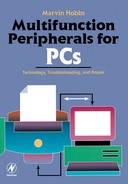Introduction
Personal computers have been associated with peripherals since their inception. The most common single-function peripheral has been the printer. Recent surveys have shown that more than 25 million printers have been installed with Windows-95-based PCs. Prior to that, single-function scanners and fax cards have been associated with PCs to make possible computer fax.
For several years PCs and fax machines sat side by side in offices without utilizing the printer and scanner in the fax machine to replace separate single-function printers and scanners used by PCs. However, during the 1980s, it became apparent to some inventors that fax machines could be altered in their design to replace the single-function devices. Other inventors tried to develop interface units to connect between unaltered fax machines and PCs. Patents were also granted to equip digital copiers with optional fax functions and PC interfaces. Thus, multifunction peripherals for personal computers evolved and were developed.
ARE THEY FAX MACHINES, PRINTERS, CONTROL CENTERS, OR ALL THREE?
Today most multifunction PC peripherals are basically fax machines with their printers arranged so they can be controlled by the PC. In their normal fax function, they scan documents for transmission and print copies of received information. In addition, they provide for PC-fax. In this mode information from the PC can be transmitted, received, and stored in the PC files. In the print mode, any information supplied by the PC can be printed as hard copy. The scanner of the multifunction machine can also scan documents into signals to be fed to the PC.
The primary functions of multifunction peripherals may be presented in different ways depending upon which function their manufacturer or seller wishes to emphasize. Canon and Hewlett-Packard present them as printers, because of their expertise in inkjet printing. Now, with color printing becoming less expensive through advances in inkjet technology, this emphasis is being reinforced. A good example can be seen by contrasting the user manuals of the Canon Multipass C5000 and the Brother MFC-7000FC. In Chapter 1 of its user manual Canon thanks the purchaser for buying the Canon Multipass C5000—the multitalented color printer—and follows with “Printing with the Multipass C5000” in Chapter 2. Canon does not get around to sending faxes until Chapter 4 on page 74. In its user manual, Brother thanks the owner for buying a Brother Multi-Function Center (MFC), mentions fax sending and receiving on page 2, starts on “Basic Fax Operation” on page 17, and does not get to using the MFC as a printer until Chapter 9 on page 71.
Also, in some models, Canon and Hewlett-Packard dispense with the fax function and offer multifunction peripherals with only printer, scanner, and copier functions. Examples of this approach are seen in H-P’s low-cost Series 300 and in their 1170C. The latter is a color copier with separate printing and scanning functions. In another version, the 1175C, faxing is made possible only through the PC and appropriate software. From a marketing viewpoint, it appears advantageous to present the multifunction unit as a printer. PC owners may be far more inclined to purchase a printer (especially a color one) than to purchase a new fax machine. However, they will take the fax function as a secondary benefit, if they can be satisfied with the printer in the MFC. Also, the fax function is often made optional in high-cost digital copiers, but can be provided through expansion units.
Multifunction machines, associated with personal computers, have been described under various names and acronyms:
The last term covers their function generally, so in this book they will be designated as Multifunction peripherals (MFPs).
